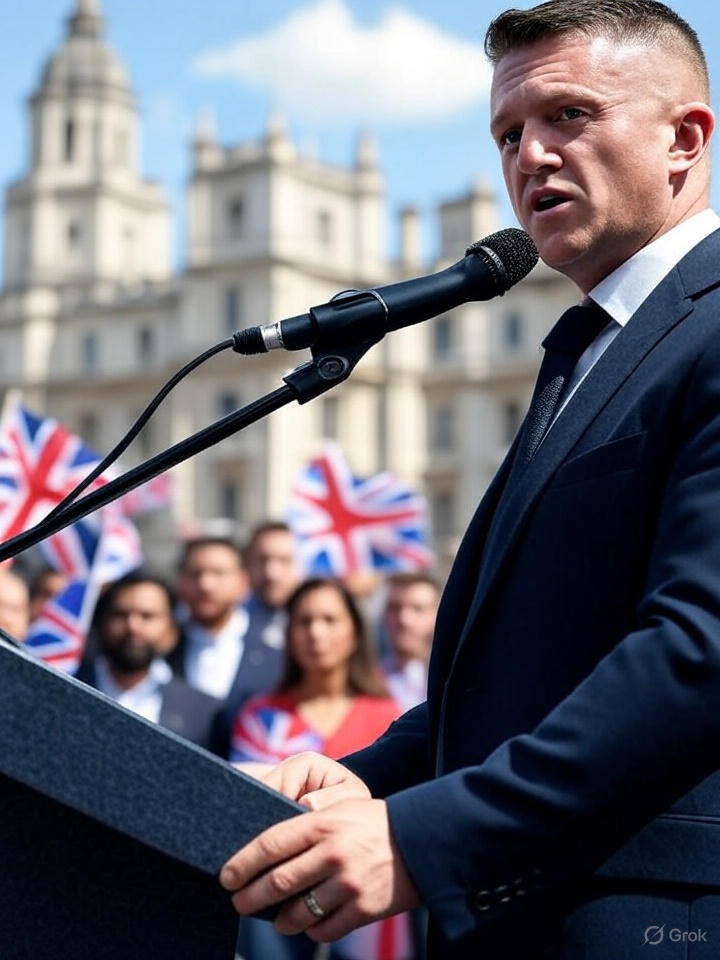Thousands of participants gathered in central London for the Unite the Kingdom rally, organized by activist Tommy Robinson, also known as Stephen Yaxley-Lennon. The event, billed as a free speech festival, began with an assembly at Stamford Street in Southwark and proceeded as a march toward Whitehall, concluding with speeches at the southern end of the route. Organizers estimated attendance in the millions, while police figures placed it between 100,000 and 150,000, with the procession stretching across several city blocks and surrounding landmarks like a major movie theater in Waterloo. The rally featured a lineup of speakers and performers, including former actor Laurence Fox, television personality Ant Middleton, and Apprentice contestant Katie Hopkins. Elon Musk addressed the crowd via video link, discussing topics related to migration and free expression. The Metropolitan Police deployed significant resources, including over 1,000 officers from across the UK, to manage the event alongside five Premier League football matches in the capital. Restrictions under the Public Order Act established a sterile area to separate participants from a concurrent counter-demonstration by Stand Up to Racism, which assembled at Russell Square and drew approximately 5,000 attendees. Barriers and mounted units were utilized to maintain order, and police engaged with organizers to ensure compliance with designated routes and timelines. The main rally was authorized until 6 p.m., though some participants remained in the area into the evening. During the march, interactions with law enforcement occurred, resulting in 25 arrests for offenses including assaults on officers and breaches of public order conditions. Twenty-six police officers sustained injuries, with four classified as serious, prompting the deployment of reinforcements. Assistant Commissioner Matt Twist commended officers for their handling of the situation without bias, noting that post-event investigations were underway to address those involved in altercations. No major injuries were reported among rally participants, and the event proceeded without widespread disruption to surrounding areas or football fixtures. The counter-protest by Stand Up to Racism proceeded peacefully, with participants marching from Russell Square to a separate endpoint, allowing both groups to exercise their rights under police oversight. Commander Clair Haynes emphasized that authorities approached all demonstrations equally, prioritizing public safety and lawful expression. The dual events highlighted London’s capacity to accommodate multiple assemblies simultaneously, with traffic management and public advisories in place to minimize impacts on daily routines. Robinson, who had been released from prison earlier in the year, framed the rally as the start of a cultural movement focused on national issues, including migration policies and community concerns. Attendees carried Union Jack flags and chanted in support of themes like patriotism and free speech, with some referencing recent events such as the killing of conservative activist Charlie Kirk. Video footage captured large crowds on Westminster Bridge and along the route, underscoring the scale of participation. The event’s organization included advance planning for logistics, such as meeting points and expected durations, to facilitate smooth progression. In the broader context, the rally followed a series of public demonstrations across the UK over summer months, often centered on local matters like asylum seeker accommodations and community safety. London’s infrastructure, including its bridges and central thoroughfares, accommodated the flow without major blockages, though some overspill into adjacent streets was noted. Media coverage varied, with organizers disputing lower estimates and highlighting the event’s significance as a platform for dialogue. Outcomes included heightened awareness of free speech discussions, as evidenced by social media engagement and international attention from figures like Musk. Police confirmed that the majority of participants adhered to guidelines, contributing to the event’s completion without escalation. Investigations into specific incidents will inform future policing strategies for large-scale gatherings. The rally’s success in drawing diverse speakers and crowds positions it as a key moment in ongoing public discourse, with plans for continued advocacy outlined by organizers. Public transport and local businesses reported minimal long-term disruptions, allowing normal activities to resume promptly. This gathering reinforced the role of protests in democratic processes, providing a venue for voices on national priorities while demonstrating coordinated management by authorities. Follow-up actions may include community outreach to address concerns raised, fostering ongoing engagement between citizens and officials.
www.34news.online
www.34news.online

